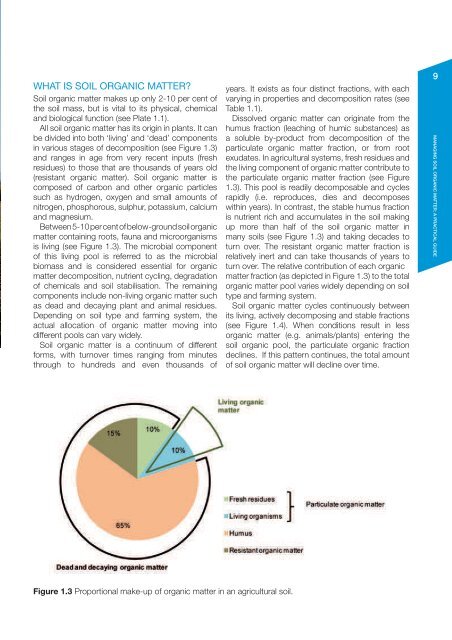managing soil organic matter - Grains Research & Development ...
managing soil organic matter - Grains Research & Development ...
managing soil organic matter - Grains Research & Development ...
You also want an ePaper? Increase the reach of your titles
YUMPU automatically turns print PDFs into web optimized ePapers that Google loves.
WHAT IS SOIL ORGANIC MATTER?Soil <strong>organic</strong> <strong>matter</strong> makes up only 2-10 per cent ofthe <strong>soil</strong> mass, but is vital to its physical, chemicaland biological function (see Plate 1.1).All <strong>soil</strong> <strong>organic</strong> <strong>matter</strong> has its origin in plants. It canbe divided into both ‘living’ and ‘dead’ componentsin various stages of decomposition (see Figure 1.3)and ranges in age from very recent inputs (freshresidues) to those that are thousands of years old(resistant <strong>organic</strong> <strong>matter</strong>). Soil <strong>organic</strong> <strong>matter</strong> iscomposed of carbon and other <strong>organic</strong> particlessuch as hydrogen, oxygen and small amounts ofnitrogen, phosphorous, sulphur, potassium, calciumand magnesium.Between 5-10 per cent of below-ground <strong>soil</strong> <strong>organic</strong><strong>matter</strong> containing roots, fauna and microorganismsis living (see Figure 1.3). The microbial componentof this living pool is referred to as the microbialbiomass and is considered essential for <strong>organic</strong><strong>matter</strong> decomposition, nutrient cycling, degradationof chemicals and <strong>soil</strong> stabilisation. The remainingcomponents include non-living <strong>organic</strong> <strong>matter</strong> suchas dead and decaying plant and animal residues.Depending on <strong>soil</strong> type and farming system, theactual allocation of <strong>organic</strong> <strong>matter</strong> moving intodifferent pools can vary widely.Soil <strong>organic</strong> <strong>matter</strong> is a continuum of differentforms, with turnover times ranging from minutesthrough to hundreds and even thousands ofyears. It exists as four distinct fractions, with eachvarying in properties and decomposition rates (seeTable 1.1).Dissolved <strong>organic</strong> <strong>matter</strong> can originate from thehumus fraction (leaching of humic substances) asa soluble by-product from decomposition of theparticulate <strong>organic</strong> <strong>matter</strong> fraction, or from rootexudates. In agricultural systems, fresh residues andthe living component of <strong>organic</strong> <strong>matter</strong> contribute tothe particulate <strong>organic</strong> <strong>matter</strong> fraction (see Figure1.3). This pool is readily decomposable and cyclesrapidly (i.e. reproduces, dies and decomposeswithin years). In contrast, the stable humus fractionis nutrient rich and accumulates in the <strong>soil</strong> makingup more than half of the <strong>soil</strong> <strong>organic</strong> <strong>matter</strong> inmany <strong>soil</strong>s (see Figure 1.3) and taking decades toturn over. The resistant <strong>organic</strong> <strong>matter</strong> fraction isrelatively inert and can take thousands of years toturn over. The relative contribution of each <strong>organic</strong><strong>matter</strong> fraction (as depicted in Figure 1.3) to the total<strong>organic</strong> <strong>matter</strong> pool varies widely depending on <strong>soil</strong>type and farming system.Soil <strong>organic</strong> <strong>matter</strong> cycles continuously betweenits living, actively decomposing and stable fractions(see Figure 1.4). When conditions result in less<strong>organic</strong> <strong>matter</strong> (e.g. animals/plants) entering the<strong>soil</strong> <strong>organic</strong> pool, the particulate <strong>organic</strong> fractiondeclines. If this pattern continues, the total amountof <strong>soil</strong> <strong>organic</strong> <strong>matter</strong> will decline over time.9MANAGING SOIL ORGANIC MATTER: A PRACTICAL GUIDEFigure 1.3 Proportional make-up of <strong>organic</strong> <strong>matter</strong> in an agricultural <strong>soil</strong>.
















